This article analyzes the Best Crypto Bridges and Aggregators for Cross-Chain Liquidity. Cross-chain bridges and aggregators have become essential tools in the crypto space.
These bridges enable seamless token transfers and access to liquidity between multiple blockchain networks.
DeFi users, traders, and developers can move assets easily, with lower fees, slippage, and speed.
Key Points & Best Crypto Bridges and Aggregators For Cross-Chain Liquidity
ThorChain – Decentralized liquidity protocol enabling cross-chain swaps without wrapped tokens.
Portal Token Bridge – Enables fast transfers between Ethereum, Binance Smart Chain, and Solana networks.
cBridge (Celer Network) – Efficient, secure, and low-cost cross-chain token transfers.
Avalanche Bridge – Optimized for transferring assets between Ethereum and Avalanche ecosystems.
Wormhole – Connects Solana with Ethereum, Terra, BSC, and other major chains.
ChainBridge – Open-source modular framework for bridging tokens and data across chains.
RenBridge (RenVM) – Trustless cross-chain asset transfer, especially for BTC, BCH, and ZEC.
AnySwap Router – Aggregates multiple bridges to route tokens via the fastest and cheapest path.
Hop Protocol – Layer-2 bridge aggregator for fast token transfers across Ethereum rollups.
Synapse Protocol – Multi-chain liquidity network with swaps and bridging for major chains.
10 Best Crypto Bridges and Aggregators For Cross-Chain Liquidity
1. ThorChain
ThorChain is a decentralized liquidity protocol that facilitates cross-chain swaps without the need for wrapped tokens.
It does not use traditional bridges, and it natively manages assets of the Bitcoin, Ethereum, and Binance Smart Chain networks.
ThorChain allows direct asset swaps by using a Continuous Liquidity Pool (CLP) model while incentivizing liquidity providers to maintain swaps.
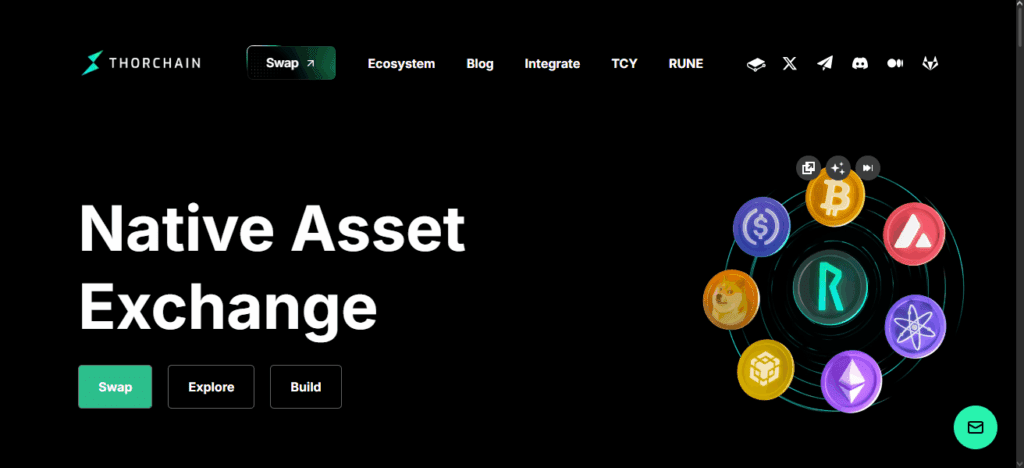
RUNE is ThorChain’s native token. It secures the network and facilitates cross-chain transactions.
Users choosing ThorChain for cross-chain swaps appreciate its non-custodial and trustless nature, avoiding reliance on wrapped and synthetic tokens.
| Feature | Description |
|---|---|
| Type | Decentralized cross-chain liquidity protocol |
| Supported Chains | Bitcoin, Ethereum, Binance Smart Chain, Litecoin, others |
| Native Token | RUNE |
| Key Function | Native asset swaps without wrapped tokens |
| Liquidity Model | Continuous Liquidity Pool (CLP) |
| Security | Non-custodial, decentralized nodes |
| Use Case | Trustless cross-chain swaps and liquidity provision |
| Speed | Moderate (depends on network confirmations) |
| Fees | Competitive, dynamic based on liquidity pool |
| Unique Advantage | Swaps real assets natively without synthetic tokens |
2. Portal Token Bridge
Portal Token Bridge specializes in rapid and secure transfers of tokens across major blockchains.
It facilitates the transfer of a wide range of assets, including ERC-20, BEP-20, and even native tokens, making it suitable to the needs of traders and users in DeFi.
The bridge aims to provide rapid transactions with minimal fees while ensuring security with multi-signature validators.
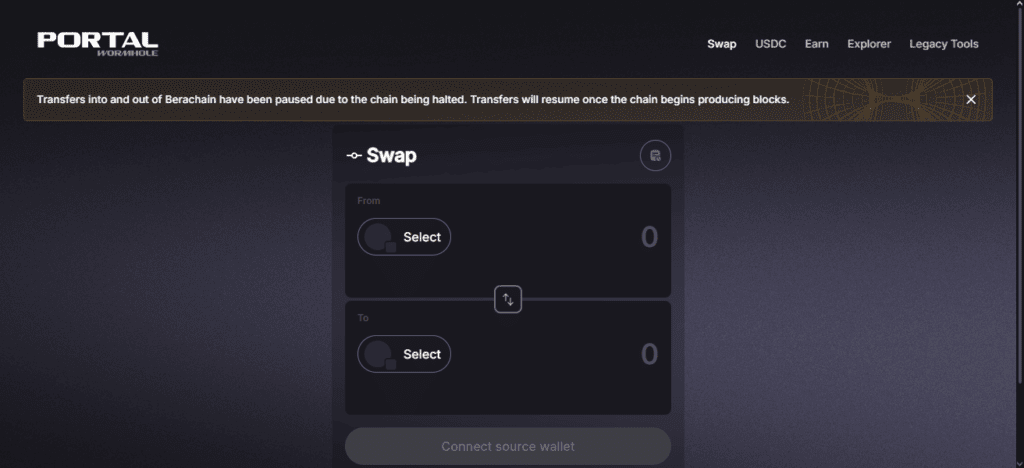
Users can also connect to other DeFi protocols, enhancing liquidity and cross-chain yield farming.
It also has advanced features and low-latency token transfers for institutional users. The simple interface makes cross-chain swaps easy for novice users.
| Feature | Description |
|---|---|
| Type | Cross-chain token bridge |
| Supported Chains | Ethereum, Binance Smart Chain, Polygon, others |
| Key Function | Token transfers across multiple blockchains |
| Security | Multi-signature validator network |
| Fees | Low fees for transfers |
| Speed | Fast, optimized for instant transfers |
| User Interface | Beginner-friendly, web-based |
| Integration | Compatible with DeFi protocols |
| Use Case | Retail and institutional cross-chain transfers |
| Unique Advantage | Combines low fees, high speed, and multi-chain support |
3. cBridge (Celer Network)
cBridge is a high-performance cross-chain bridge and liquidity network able to integrate over 100 cross-chain assets and major blockchains.
Built on Layer-2 and multi-chain liquidity pools, cBridge offers instantaneous and low-cost fund transfers.
To ensure security, cBridge employs a decentralized network of validators and off-chain scaling solutions which alleviate congestion and high fees on Layer-1.
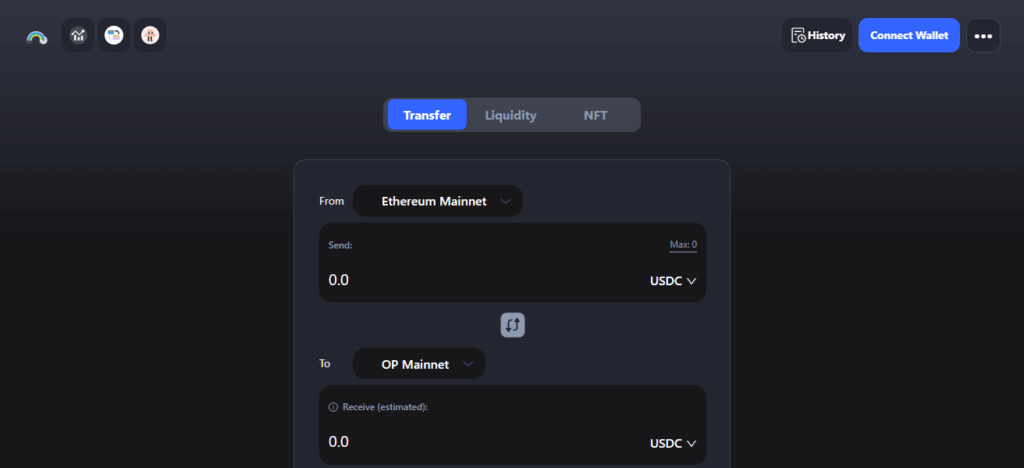
cBridge also specializes in liquidity aggregation, efficiently optimizing and routing assets. With user-friendliness, interoperability, and transfer speed
cBridge focuses on providing a seamless experience for DeFi customers, allowing for effortless token exchanges between Ethereum, Binance Smart Chain, and Polygon.
| Feature | Description |
|---|---|
| Type | Cross-chain bridge & liquidity network |
| Supported Chains | Ethereum, Binance Smart Chain, Polygon, Arbitrum, Avalanche, others |
| Key Function | Instant token transfers across chains |
| Security | Decentralized validator network |
| Liquidity Model | Multi-chain liquidity pools |
| Fees | Low, optimized via Layer-2 solutions |
| Speed | Instant transfers using off-chain scaling |
| User Interface | Easy-to-use, with routing optimization |
| Integration | Works with major DeFi protocols |
| Unique Advantage | High-performance Layer-2 cross-chain bridge |
4. Avalanche Bridge
Avalanche Bridge (AB) enables the movement of Avalanche to Ethereum, allowing users to transfer ERC-20 tokens with low fees and high security.
Avalanche Bridge uses intelligent contracts alongside Avalanche’s consensus mechanism, which allows for almost instant execution.

In comparison to other bridges, The Avalanche Bridge offers lower gas fees and is compatible with major crypto assets like USDC, ETH, and other stablecoins, and offers security via audited frameworks and strong validation.
This makes the bridge ideal for retail users and institutions. Due to the increase of DeFi on Avalanche
AB makes the Ethereum and Avalanche ecosystems synchronous for traders, developers and liquidity providers to access cross-chain yield opportunities efficiently.
| Feature | Description |
|---|---|
| Type | Ethereum ↔ Avalanche token bridge |
| Supported Chains | Ethereum, Avalanche |
| Key Function | Transfers ERC-20 and native tokens |
| Security | Audited smart contracts, robust validation |
| Fees | Significantly lower than Ethereum mainnet transfers |
| Speed | Near-instant finality due to Avalanche consensus |
| Assets Supported | ETH, USDC, stablecoins, major ERC-20 tokens |
| User Interface | Simple web-based interface |
| Use Case | Moving liquidity between Ethereum and Avalanche |
| Unique Advantage | Fast, secure, and low-cost cross-chain transfers |
5. Wormhole
Wormhole is a well known cross chain bridge. Wormhole connects Solana, Ethereum, Binance Smart Chain, and Terra along with a few more networks.
Users can transfer tokens and NFTs across different chains. Bridges a collection of ecosystems that don’t normally work together.
Wormhole is typically used in DeFi and NFT applications that want a cross chain functionality.

Wormhole offers DeFi and NFT applications access liquidity and assets across chains without the need for wrapping them or using synthetic tokens.
Wormhole Scalability and support for a multitude of assets is a key piece of infrastructure in the cross chain DeFi landscape.
| Feature | Description |
|---|---|
| Type | Cross-chain bridge |
| Supported Chains | Solana, Ethereum, Binance Smart Chain, Terra, others |
| Key Function | Token and NFT transfers across chains |
| Security | Guardian network verification |
| Speed | Fast, near real-time transfers |
| Assets Supported | ERC-20, SPL tokens, NFTs |
| User Interface | Web-based, DeFi integrations |
| Fees | Low to moderate, depending on chain |
| Use Case | Interoperability between Solana and other ecosystems |
| Unique Advantage | Cross-chain NFT and DeFi asset bridge |
6. ChainBridge
ChainBridge is a modular cross chain bridge built by ChainSafe with a focus on secure transfer of tokens and data across blockchains.
It works with Ethereum, Binance Smart Chain, and Polygon. ChainBridge’s architecture gives the developers the ability to set and control validators, assets, and transaction clauses for customization.

It’s decentralized method of bridge design and architecture greatly reduces the need of overpriced, centralized operators. Along with smart contract execution in cross chain DeFi applications
ChainBridge also focus on the transfer of data across chains for complete control over complex contract domains.
Multi-chain ecosystems depend on tightly woven cross chain systems for liquidity and security. ChainBridge ensures this to the developers.
| Feature | Description |
|---|---|
| Type | Modular cross-chain bridge |
| Supported Chains | Ethereum, Binance Smart Chain, Polygon, others |
| Key Function | Token and data transfer between blockchains |
| Security | Decentralized validator network |
| Customizability | High, supports developer configuration |
| Integration | Smart contract interoperability |
| Fees | Depends on network and transaction size |
| Speed | Moderate, network-dependent |
| Use Case | Flexible cross-chain solutions for developers |
| Unique Advantage | Modular architecture allows tailored implementations |
7. RenBridge (RenVM)
RenBridge uses RenVM tech for trustless cross-chain transfers of Bitcoin, Bitcoin Cash, Zcash, and other coins to Ethereum, Binance Smart Chain (BSC), and other networks.
It converts these assets to wrapped ERC-20 and BEP-20 tokens while maintaining full value. To secure value and privacy, RenVM operates decentralized Darknodes.
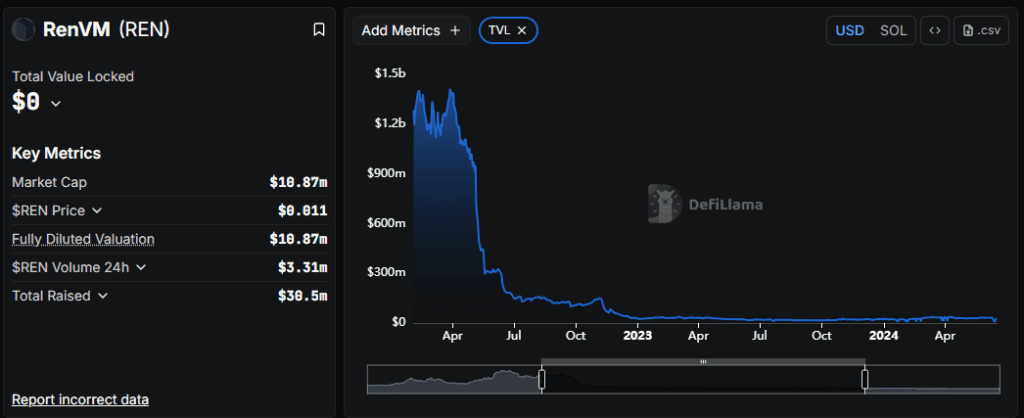
Since no single entity can control the assets, the system is secure. DeFi users primarily use it to bring Bitcoin liquidity to Ethereum-based protocols for better cross-chain capital and interoperability.
It is a non-custodial system and provides a bottomless cross-chain DeFi liquidity source. Its non-custodial model is a bottomless source of cross-chain DeFi liquidity. Its model is a cross-chain DeFi liquidity source. It’s non-custodial.
| Feature | Description |
|---|---|
| Type | Trustless cross-chain bridge |
| Supported Chains | Ethereum, Binance Smart Chain, Polygon, others |
| Key Function | Tokenizes BTC, BCH, ZEC into ERC-20/BEP-20 |
| Security | Darknodes network, fully decentralized |
| Liquidity Model | Non-custodial, trustless token wrapping |
| Fees | Moderate network-based fees |
| Speed | Fast depending on validator confirmations |
| Integration | Works with DeFi protocols |
| Use Case | Bringing Bitcoin liquidity into Ethereum-based DeFi |
| Unique Advantage | Privacy-preserving, decentralized Bitcoin bridge |
8. AnySwap Router
AnySwap Router is a cross-chain liquidity aggregator and a decentralized exchange that enables users to swap assets on different networks.
AnySwap’s token bridging offers value swap path optimization to minimize slippage and fees. AnySwap supports the Ethereum, Fantom, Binance Smart Chain, and Avalanche ecosystems.
AnySwap is a good choice to bridge defi assets in a cross-chain scenario because they focus on efficiency and security with a non-custodial bridge.
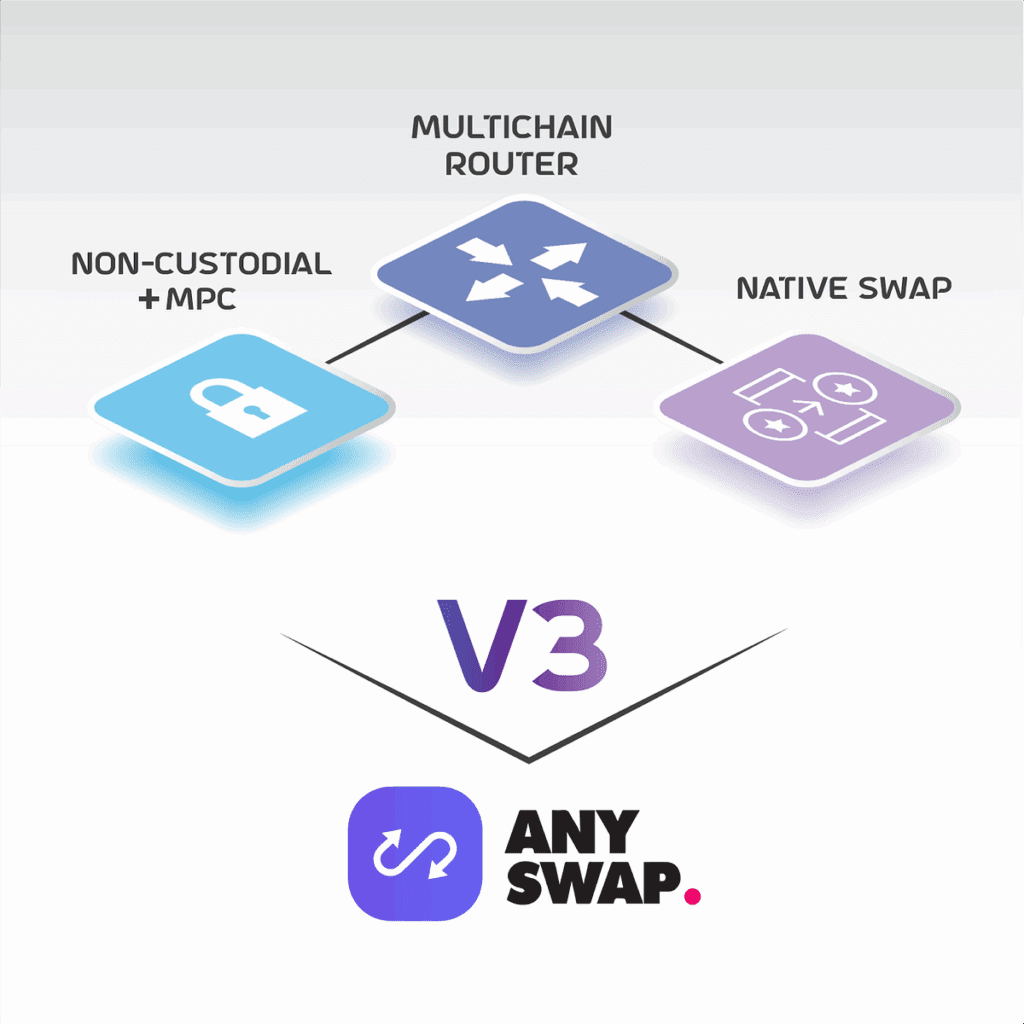
For every transaction, the AnySwap smart contract guarantees a direct and seamless token swap, eliminating the need for a trusted third party.
AnySwap Router provides liquidity for locked liquidity pools, which is essential for the defi user base, offering fast, secure, and inexpensive liquidity transitions.
| Feature | Description |
|---|---|
| Type | Cross-chain router & liquidity aggregator |
| Supported Chains | Ethereum, Binance Smart Chain, Avalanche, Fantom, others |
| Key Function | Token bridging and swapping |
| Security | Smart contracts, decentralized operations |
| Liquidity Model | Integrates with liquidity pools for deep liquidity |
| Fees | Low, optimized swap routes |
| Speed | Fast, near-instant transfers |
| Integration | Supports multiple DeFi protocols |
| Use Case | Multi-chain token swaps with minimal slippage |
| Unique Advantage | Automatic optimal routing for cross-chain swaps |
9. Hop Protocol
Hop Protocol presents a Layer-2 scaling and cross-chain bridge solution for Ethereum and Ethereum Layer-2 networks and Polygon.
Hop allows for instantaneous token transfers and Hop eliminates waiting for multiple confirmations at a network and Hop reduces transfer fees and congestion.
Hop liquidity pools on each network trustlessly enable swaps and Hop eliminates the need for wrapping and custodian services.

Hop speed and efficiency focus on frequent traders and DeFi users who need to shift assets across chains.
Hop slippage and transfer costs are low by optimizing routing and liquidity use which improves cross-chain asset transfer in Hop Protocol.
| Feature | Description |
|---|---|
| Type | Layer-2 scaling bridge |
| Supported Chains | Ethereum, Optimism, Arbitrum, Polygon |
| Key Function | Instant token transfers between L2 networks |
| Security | Decentralized liquidity pools for trustless swaps |
| Fees | Low, optimized via Layer-2 scaling |
| Speed | Near-instant finality |
| Liquidity Model | Pools on each Layer-2 network |
| Use Case | Frequent traders, DeFi users moving assets across L2s |
| Unique Advantage | Efficient Layer-2 cross-chain swaps with minimal gas |
10. Synapse Protocol
Synapse Protocol functions as a multi-chain liquidity and cross-chain swap interface that services Ethereum, Avalanche, BSC, and other leading chains.
It enables almost instant and highly affordable token transfers. Advanced bridging and liquidity aggregation are clearly overcome with Synapse Liquidity as it dynamically routes liquidity and reduces slippage for avalanche terminus.
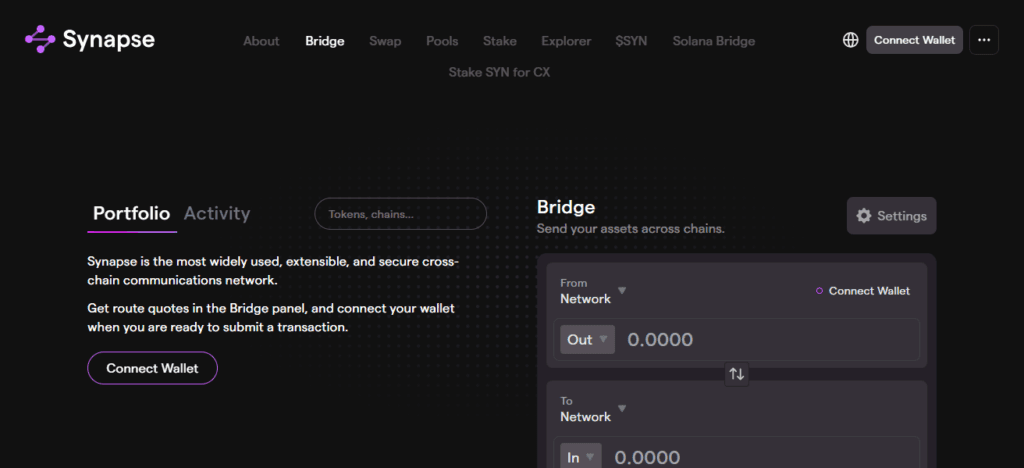
Its innovative and modular design accommodates lost-cost stablecoins, any ERC-20 token, and other native blockchain assets, offering them for liquidity.
Synapse also makes a point of security with audited smart contracts and decentralized validator nodes.
Synapse facilitates capital-efficient cross-chain swaps and access to liquidity to enhance integration, for which it is highly valued by multi-chain ecosystem traders, developers, and liquidity providers.
| Feature | Description |
|---|---|
| Type | Multi-chain liquidity & cross-chain swap protocol |
| Supported Chains | Ethereum, Avalanche, Binance Smart Chain, Polygon, others |
| Key Function | Token bridging and swapping with optimal routing |
| Security | Audited smart contracts, validator nodes |
| Liquidity Model | Aggregated liquidity for low slippage swaps |
| Fees | Low, optimized across chains |
| Speed | Near-instant finality |
| Integration | Supports stablecoins, ERC-20, and native assets |
| Use Case | Multi-chain DeFi and liquidity access |
| Unique Advantage | Deep liquidity and efficient routing across chains |
Conclsuion
To conclude, Cross-chain bridges and aggregators are crucial for integration of different block ecosystems. They provide seamless transfers of tokens, access liquidity and swaps to be conducted in a decentralized manner.
ThorChain, Wormhole and Synapse focus on different integration, being speed, security and efficiency. All three of them provide the ability for people and DeFi projects to transfer their assets to different blockchains without complication.
When it comes to bridges, the most critical trade off variables are the chains to be connected, the trade off and the liquidity requirements.
FAQ
A crypto bridge connects different blockchains, enabling seamless token transfers and cross-chain interactions.
Aggregators route transactions through multiple bridges or liquidity pools to optimize speed, fees, and slippage.
They provide access to liquidity, DeFi platforms, and tokens across multiple blockchain ecosystems.
Most are secure, but risks exist. Always use audited, reputable bridges and avoid unverified platforms.
ThorChain enables native asset swaps across chains without wrapping or synthetic tokens.














Leave a Reply